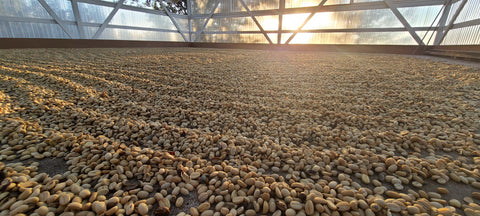Kona Coffee is a delicious, specialty coffee grown exclusively on the Big Island of Hawaii. The rich, volcanic terroir of Kona creates a coffee with unique characteristics and a flavor that is unlike any other.
Kona Coffee is prized for its rich, full-bodied flavor with notes of chocolate, caramel, and nuts. The coffee has a bright acidity that gives it a lively character and a smooth, silky finish. Kona Coffee is truly a coffee lover's dream. But how does it get from the crop to your cup? Read on for six critical steps in the coffee production process.

Kona Coffee Farmer Steve Wynn
Step 1: Farm Management
When it comes to Kona coffee farming, harvest certainly plays a starring role. However, equally as important is farm management. Throughout the year, the farmer must care for the coffee orchard to ensure a successful crop. Farm management practices such as pruning, fertilizing, and pest control are essential to producing high-quality coffee cherries.
Pruning helps keep the coffee plant healthy by removing diseased or damaged branches. It also allows the plant to direct its energy into producing high-quality coffee cherries.
Fertilizing is another crucial element of farm management. The right type and amount of fertilizer can mean the difference between a bountiful crop and a lackluster one.
Pest control is also vital to maintaining a healthy coffee orchard. Kona coffee plants are susceptible to damage from both CBB (coffee berry borer) and CLR (coffee leaf rust). Both of these pests can decimate a coffee crop if left unchecked.
Kona coffee picker during harvest
Step 2: Harvesting
Coffee grows on trees and the fruit that these trees produce is called cherry. What starts as a delicate white blossom known as "Kona snow" becomes a fruit about the size of a cranberry. The color develops from bright green to yellow, orange, and ultimately, a deep rich red the color of a ripe cherry. At this point, the grower knows it is time to pick.
Unlike other coffee-producing regions that use mechanical picking, Kona coffee is harvested by hand. This allows for a very selective picking process which results in only the highest quality coffee cherries being used to produce Kona coffee.
At Kona Earth's elevation of 2200 feet, the picking season generally runs from September through March, with the peak picking occurring in November and December.
 Kona Earth pulper/demucilager used during wet milling
Kona Earth pulper/demucilager used during wet milling
Step 3: Wet Processing
After the coffee cherries are picked, they are brought to a pulper/de-mucilager where the outer fruit is removed from the coffee bean. The coffee bean is encased in a thin parchment layer and surrounded by a sticky, sugary mucilage, which is also removed during this process. Water is used throughout the process to help remove the fruit and mucilage.
What is left is a seed, often referred to as a "bean", though it is not technically a legume. Typically, the seed has two halves. However, in a small percentage of harvest (about 5%), an anomaly occurs. The peaberry is a single, rounded seed that is prized for its quality and unique flavor profile.
Wet processing is the most common method of coffee bean processing and results in a coffee with a clean taste and bright acidity.
Kona coffee drying deck
Step 4: Drying
After the coffee beans have been pulped, they are then dried. Drying coffee beans can be done in one of two ways: sun-drying or mechanical drying.
Sun drying is the most traditional method of drying coffee beans and is still used today in Kona coffee production. The coffee beans are spread out on large drying decks to dry in the sun. This method can take up to two weeks, and the coffee beans must be turned or "raked" frequently to ensure even drying.
Mechanical drying is a faster method of drying coffee beans and is often used as a complement to sun drying. The coffee beans are placed in large mechanical dryers where they are circulated and heated until they reach the desired moisture content.
To qualify under the Hawaii specialty coffee grading standards, Kona coffee moisture content must fall between 9% and 12%. The grower must monitor moisture throughout the drying process to ensure it doesn't fall outside of these parameters. If the coffee beans get too dry, they will become brittle and break during roasting. If the coffee beans are too wet, they will not roast evenly and will produce a poor-quality coffee. Not too dry, not too wet, Kona coffee beans have to be "just right".
Kona Earth owners Steve and Joanie Wynn in coffee storage room
Step 5: Milling/Hulling
After the coffee beans have been dried, they are ready for dry-milling. The dry mill is where the coffee beans are hulled and sorted. The first step in the dry milling process is to remove the parchment layer that is still surrounding the coffee bean. This can be done with a machine called a "huller" or a "decorticator".
After the parchment has been removed, the coffee beans are sorted by size. The largest beans have a screen size of 19 while the smaller beans have a screen size of 16. Screen 19 is considered a premium bean, often referred to as Extra Fancy. Beans that are too small, broken, or have significant defects are not used in the production of Kona coffee. What results from the first five steps is a green Kona coffee bean that is stored in a temperature and humidity-controlled room until it is ready to be roasted.
Kona Earth micro-roasts in small quantities
Step 6: Roasting
Roasting puts the icing on the cake, so to speak. Equal parts science and art, the roasting process brings out the unique flavor profile of each coffee, carefully monitoring temperature, time, and color to achieve the desired roast profile.
We call the above-listed steps "critical" because failure in any one will result in a compromised final outcome. Attention at every stage of the process ensures that each and every Kona coffee bean meets the highest standards.
A Labor of Love
Kona coffee growers take great pride in producing this world-renowned Hawaiian specialty coffee. These six critical steps in the process take the promise of a Kona coffee crop to an aromatic and delicious final cup.
Want to learn more? Check out our You Tube channel for a series of video clips on the process.






